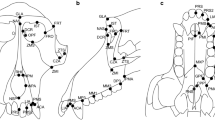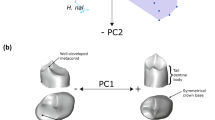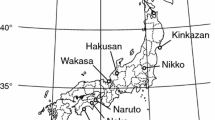Abstract
We quantitatively examined the differences in the size and proportion of the Japanese macaque (Macaca fuscata) by comparing the Early Jomon specimens from Torihama shell-midden, Fukui Prefecture and modern specimens from Fukui Prefecture. The purpose of this study was to explore the temporal change in the proportion and size of teeth of the Japanese macaques based on the quantified data. The result of measurements of lower premolars and molars demonstrated that sexual dimorphism was evident only among the modern specimens where the females were significantly smaller than males. The size of male Torihama specimens was within the range of the modern population, whereas the size of the female Torihama specimens was significantly larger than the modern female population. The proportional pattern of premolars and molars for male and female Torihama specimens also differed. The results may suggest a possible difference in the degree of size reduction between males and females since the last glacial period.




Similar content being viewed by others
References
Aimi M (2002) The oldest fossil macaque from Japan (in Japanese with English abstract). Primate Res 18:239–245
Board of Education of Fukui Prefecture and Wakasa History and Folklore Museum (1983) The research of Torihama shell-midden, 1981, 1982 excavation season. Board of Education of Fukui Prefecture, Wakasa History and Folklore Museum, Fukui (in Japanese)
Gingereich PD, Schoeninger MJ (1979) Patterns of tooth size variability in the dentition of primates. Am J Phys Anthropol 51:457–466
Hasebe K (1924) The Japanese macaque from the Paleolithic Period (in Japanese). J Anthropol Soc Nippon 39:217–218
Hasebe K (1925) The mandible of Japanese macaque from Shimosou Tokuhashi Shell-midden (in Japanese). J Anthropol Soc Nippon 40:437–442
Hongo H, Fujita M, Matsui A (2002) The change in the distribution of Japanese macaque from the archaeological sites (in Japanese). Asian Paleoprimatol 2:1–12
Iwamoto M (1975) On a skull of a fossil macaque from the Shinkimizu Limestone Quarry in the Shikoku District, Japan. Primates 16:83–94
Iwamoto M (1981) Remains of the Japanese Monkey (Macaca fuscata) from Takaga-ana Limestone Cave in Akiyoshi-dai District, Japan. Bulletin of Nishi Akiyosi-dai Takaga-ana Limestone Cave Research. Board of Education of Akiyoshi-cho, Akiyoshi, pp159–166 (in Japanese)
Iwamoto M, Hasegawa Y (1972) Two macaque fossil teeth from the Japanese Pleistocene. Primates 13:77–81
Kondo K (1987) Morphological diversity in the teeth of Japanese macaque (Macaca fuscata). Master Thesis for Tokyo University (1986) (in Japanese)
Kuroda S (1989a) The Japanese macaque from the Boso Peninsula (1) (in Japanese). Monkey 33(1):4–12
Kuroda S (1989b) The Japanese macaque from the Boso Peninsula (2) (in Japanese). Monkey 33(2):12–14
Mouri T (1981) The Japanese macaque from the Torihama shell-midden (in Japanese). Monkey 25(1):16–18
Nishida M (1981) The man, forest, and animals of the Early Jomon Period (in Japanese). Monkey 25(1):6–15
Plavcan JM (2001) Sexual dimorphism in primate evolution. Yrb Phys Anthropol 44: 25-53.
Saheki M (1966) Morphological studies of Macaca fuscata: IV. Dentition. Primates 7:407–422
Shigehara N, Kaneko H, Iwamoto M (2002) The teeth of Japanese macaque (Macaca fuscata) from the archaeological sites (in Japanese). Asian Paleoprimatol 2:21–36
Shikama T, Okafuji G (1958) Quaternary cave and fissure deposits and their fossils in Akiyoshi district, Yamaguti Prefecture. Sci Rep Yokohama National Univ 2(7):43–103
Sokal RR, Rohlf FJ (1995) Biometry. Freeman, New York
Swindler DR (1976) Dentition of living primates. Academic Press, London
Swindler DR (2002) Primate dentition. Cambridge University Press, Cambridge
Wood BA (1976) The nature and basis of sexual dimorphism in the primate skeleton. J Zool 180: 15-34
Yoshimi I, Takasaki H (2003) Long distance mobility of male Japanese macaques evidenced by mitochondrial DNA. Primates 44:71–74
Acknowledgements
We wish to thank Prof. Katsuhiko Amitani (Tsuruga Junior College) and Wakasa History and Folklore Museum, Fukui Prefecture, the Collection Committee of the Kyoto University Primate Research Institute (KUPRI) for the permission to work on the material. We are grateful to M. Takai and to the staffs of Systematics and Phylogeny Section and Morphology Section of KUPRI for many constructive suggestions for the present study. The study is supported by the Grant-in-Aid for Scientific Research (16405018 to M. Takai), and by the Grant for the Biodiversity Research of the 21st Century COE Program (A14 to Kyoto University).
Author information
Authors and Affiliations
Corresponding author
Additional information
Morphometric analysis of mandibular cheek teeth from Torihama Shell-midden
About this article
Cite this article
Anezaki, T., Hongo, H. & Shigehara, N. A morphometric analysis of the Japanese macaque (Macaca fuscata) mandibular cheek teeth from the Torihama Shell-midden, Early Jomon Period, Fukui Prefecture, Japan. Primates 47, 255–263 (2006). https://doi.org/10.1007/s10329-005-0161-9
Received:
Accepted:
Published:
Issue Date:
DOI: https://doi.org/10.1007/s10329-005-0161-9




